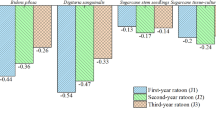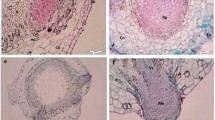Abstract
THE activity of skatole as a growth-promoting substance has been noted by Glover1. We have carried out experiments which show that skatole accelerates root formation in cuttings. Cuttings of Leptospermum sooparium and of Ficus repens were treated with an aqueous solution of skatole in the manner described by Hitchcock and Zimmerman2, and the cuttings planted in a mixture of coco-nut fibre and sand in a propagator. The treatment accelerated root production. With Leptospermum scoparium cuttings, treatment for six hours with skatole solution of a concentration of 20 mgm. per 100 c.c. on March 19 gave 60 per cent of the cuttings well rooted in 20 days. A control set showed 30 per cent only of the cuttings to be slightly rooted. With Ficus repens, a more marked response was obtained. Cuttings planted on April 22 and examined after 19 days showed in the control set 10 per cent rooted with an average of 0.3 roots per cutting and an average length of root per cutting of 1·6 mm. Of cuttings treated for 3 hours with a skatole solution of a concentration of 20 mgm. per 100 c.c., 90 per cent were rooted with an average of 4·2 roots per cutting and an average length of root per cutting of 38·4 mm.
Similar content being viewed by others
References
NATURE, 137, 320 (1936).
Contrib. Boyce Thompson Inst., 8, 63 (1936).
Author information
Authors and Affiliations
Rights and permissions
About this article
Cite this article
WARNE, L., JACKSON, A. Skatole as a Root Forming Substance. Nature 140, 26–27 (1937). https://doi.org/10.1038/140026b0
Issue Date:
DOI: https://doi.org/10.1038/140026b0
- Springer Nature Limited
This article is cited by
-
Zur Methodik der Wuchsstoffbestimmung
Planta (1938)





